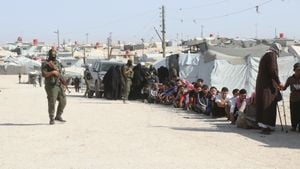Working holiday visas have become popular among young travelers seeking adventure and cultural exchange. These programs not only allow individuals to explore new countries but also play a significant role in the economies of host nations.
Australia's Working Holiday Visa program has attracted thousands of young adventurers hoping to experience life down under. This visa scheme is instrumental for enriching not just the visitors but also Australia's economy, labor market, and cultural diversity.
Working holiday makers (WHMs) are more than just tourists; they contribute heavily to sectors such as tourism and agriculture. Despite their significant impact, their contributions are often overshadowed by discussions about net migration statistics.
Two primary visa types make up this exciting opportunity: the unrestricted Working Holiday Maker visa (subclass 417) and the capped Work & Holiday visa (subclass 462). Both visa types facilitate the dual role of foreign visitors as both labor providers and consumers of tourism products.
Before the COVID-19 pandemic, the number of WHM and W&H visa grants surged remarkably. For example, between 2009-10 and 2012-13, the granted visas jumped from 183,168 to 258,248, translating to considerable economic activity.
During this period, contributions to net migration from WHM and W&H holders also increased from 18,000 to 38,400. Such figures indicate the positive influence of foreign labor on regional economies across Australia.
These trends took a downward turn post-2013 as the labor market softened after considerable growth. The pandemic caused net migration contributions to flip negative, marking the lowest records of WHM and W&H holders historically.
To revitalize these programs after COVID-19, several initiatives have emerged. Notably, the government has introduced fee-free applications and relaxed visa conditions to attract foreign workers back to the country.
These efforts have shown promise; the number of granted first WHM visas rose from 145,756 during 2022-23 to 154,704 for the following year. On the flip side, first W&H visas have seen significant declines, signaling potential challenges.
Interestingly, by 2022-23, the net migration contributions from WHM and W&H visas shot up to 70,848. This impressive rebound came amid the many hurdles experienced between 2020 and 2021.
With the labor market heating up, the government aims to adjust net migration policies moving forward. Discussions are underway to potentially restrict third WHM/W&H visa options and impose English language testing requirements for applicants.
These proposed policy changes have sparked significant opposition, especially among advocacy groups. They highlight the indispensable role of WHM and W&H holders, particularly within regional and rural communities.
Critics of migration reductions argue against undermining the economic fabric strengthened by WHM contributions. With many industries facing talent shortages, there's increasing pressure to sustain this labor flow.
While officials pledge to reduce overall migration, accomplishing those goals without impacting WHMs will be complicated. The tug-of-war between maintaining labor supply and controlling migration levels suggests upcoming political challenges.
Beyond numbers and statistics, the personal stories of WHMs reveal the transformative impact of such experiences. Take Colleen Deere’s story as one compelling example of rebirth and adventure.
Originally hailing from Carlow, Ireland, Colleen left behind her secure bank job to work on Australian vineyards. This leap of faith led her to discover the beauty of simplicity and firsthand cultural exchanges.
Colleen’s experience is more than just about finding work; it marks her transformation from tourist to local resident. It underscores the strong connections and networks formed through these shared experiences amid unique challenges.
For her, this decision wasn't solely about earning; it was about building a meaningful life enriched by cultural interactions. Many like Colleen echo similar sentiments, as they seek avenues for personal growth through these transformative programs.
At the heart of the working holiday visa program lies the opportunity for reinvention and rich life experiences. Through personal stories like her own, the invisible yet considerable impacts of WHMs emerge stronger than ever.
Even as proposals surface to tighten the visa pathways, there’s palpable support for WHMs. Locals and businesses alike recognize the critical role these individuals play within Australian society.
More than contributing to tourism and the economy, working holiday visas nds bridge cultures and promote valuable cross-cultural connections. These mutual benefits fuel the urgency of immigration discussions shifting forward.
Today, Australia finds itself at the intersection of challenges and opportunities within this visa framework. Continued discourse surrounding WHMs is critical to acknowledging their thriving contributions.
With scrutiny increasingly focused on WHMs and their future, stakeholders need to address the balance between benefits and restrictions. To sustain skilled labor and cultural exchange, revamping visa strategies could serve as a solid foundation for Australia.
By prioritizing strategic revisions over strict limitations, Australia’s status as the go-to spot for young international workers could strengthen. The promise of exploration and economic opportunity remains enticing for young people eager to step outside their comfort zones.
Colleen’s narrative resonates as both inspiration and motivation; it’s clear adventure awaits those willing to leap toward uncertainty. Her experience reflects countless others driven by dreams of discovery and reminders of the ever-expanding horizons of life.



